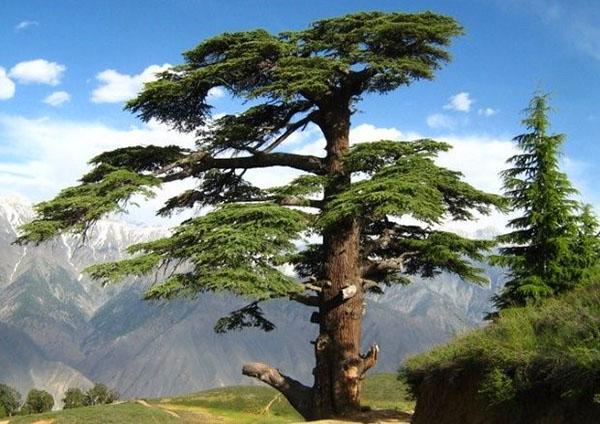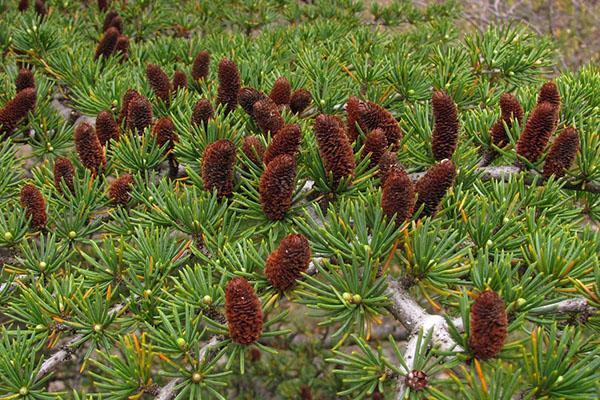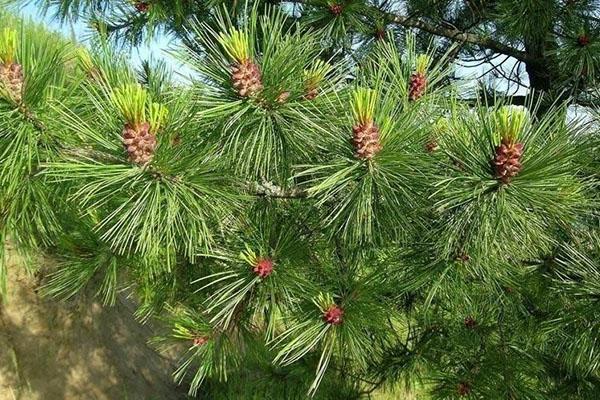How to grow a stately handsome cedar on your site
 Since ancient times, the cedar has delighted people with its natural power, beauty and healing power. It was called a tree-breadwinner, a riddle, a gift from the gods. For a long time, thickets of cedar trees have been considered sources of miraculous energy that soothes and enlightens thoughts, awakens the soul and directs feelings to everything that is beautiful on Earth. Over the course of several thousand years, during which people watched him, he not only did not lose its value, but increased it, which was confirmed by many scientific discoveries.
Since ancient times, the cedar has delighted people with its natural power, beauty and healing power. It was called a tree-breadwinner, a riddle, a gift from the gods. For a long time, thickets of cedar trees have been considered sources of miraculous energy that soothes and enlightens thoughts, awakens the soul and directs feelings to everything that is beautiful on Earth. Over the course of several thousand years, during which people watched him, he not only did not lose its value, but increased it, which was confirmed by many scientific discoveries.
Interesting facts about cedar

Cedar forests have such an intense phytoncidal force that one hectare of such a forest would be enough to purify the air in the whole city.
The ancient Sumerians revered the cedar as a sacred tree and gave names to the most magnificent specimens. Cedar wood served as a measure of exchange and was often valued more than gold. The Sumerian god Ea was considered the patron saint of the cedar, and no one could cut this tree down without the highest permission. These facts are confirmed by clay tablets found during excavations, which date back to the 5th – 4th centuries. BC. They also had a description of what the cedar looks like.
The decoration of the tomb of the Egyptian king Tutankhamun is made of cedar wood. For 3 thousand years, it not only did not deteriorate, but even retained its delicate delicate smell. Due to its qualities, cedar resin was one of the components of mummifying mixtures, and cedar oil helped to preserve the priceless ancient Egyptian papyri to this day.
The ancients built their ships from cedar wood, and the wonderful gopher tree from which Noah built his ark is a cedar growing in the valleys of Mesopotamia.
Description of the tree
 The majestic cedar belongs to the genus of the Pine family. These are monoecious, evergreen trees up to 45 meters high, with a wide-pyramidal spreading crown. They are long-livers and grow up to 400-500 years. The dark gray bark on young trees is smooth, on old ones - with cracks and scales.
The majestic cedar belongs to the genus of the Pine family. These are monoecious, evergreen trees up to 45 meters high, with a wide-pyramidal spreading crown. They are long-livers and grow up to 400-500 years. The dark gray bark on young trees is smooth, on old ones - with cracks and scales.
The needles are acicular, resinous, tough and prickly. Its color in different species varies from dark green to blue-green and silver-gray. The needles are gathered in bunches. Cedar flowers, if you can call it spikelets, up to 5 cm long with numerous small stamens and anthers. Cedar blooms in autumn.
Cones grow on branches one by one, arranged vertically, like candles. They ripen in the second or third year and crumble during the winter, scattering seeds in the wind. Once in favorable conditions, they germinate after 20 days.
Cedar seeds don't look like nuts at all. They are small, with wings for better wind dispersal and inedible.
Cedar needs light, non-compacted and breathable soils. They are very sensitive to stagnant water. Prefer soils poor in lime. On mountain slopes made of limestone, they suffer from chlorosis and often die.
They feel better in open, sunny places, but on richer soils they grow well in partial shade.
Growing area
 The places where cedar grows everywhere are the southern and eastern regions of the Mediterranean coast. Trees prefer mountainous areas with cool summers and mild winters.They are also found in the foothills of the Himalayas, in North-West Africa, in Lebanon, where the cedar is one of the national symbols and is depicted on the national flag and coat of arms.
The places where cedar grows everywhere are the southern and eastern regions of the Mediterranean coast. Trees prefer mountainous areas with cool summers and mild winters.They are also found in the foothills of the Himalayas, in North-West Africa, in Lebanon, where the cedar is one of the national symbols and is depicted on the national flag and coat of arms.
 In Russia, cedar grows only on the southern coast of Crimea, where it has successfully acclimatized and gives abundant self-seeding. In other regions, it is found only in botanical gardens and nurseries. And that tree, which is called the Siberian cedar, is actually a representative of the Pine genus and is correctly called the Siberian, European or Korean pine. These varieties are united by one family with cedars. But it is the Siberian pine that gives everyone the beloved and extremely useful "pine nuts".
In Russia, cedar grows only on the southern coast of Crimea, where it has successfully acclimatized and gives abundant self-seeding. In other regions, it is found only in botanical gardens and nurseries. And that tree, which is called the Siberian cedar, is actually a representative of the Pine genus and is correctly called the Siberian, European or Korean pine. These varieties are united by one family with cedars. But it is the Siberian pine that gives everyone the beloved and extremely useful "pine nuts".
Types of cedar
The cedar genus has 4 types:
- Atlas - Cedrus atlantica;
- short-coniferous - Cedrus brevifolia. In some sources, this species is referred to as a Lebanese subspecies;
- Himalayan - Cedrus deodara;
- Lebanese - Cedrus libani.
The structure of the cones of cedars and pines is in many ways similar, so for a long time the listed species were considered identical. But recent scientific studies have refuted this data, and now the classification separates both types.
Atlas
 Atlas cedar grows on the slopes of the Atlas Mountains in Algeria and Morocco. In its natural environment, it occurs at an altitude of 2000 m above sea level. The tree is majestic, spreading. The largest specimens reach 50 m in height, and their trunk diameter is 1.5–2 m. The needles are collected in bunches and have a bluish-green tint. The wood is resinous and aromatic, smelling like sandalwood. The Atlas species tolerates frosts down to -20 ° C and copes well with drought.
Atlas cedar grows on the slopes of the Atlas Mountains in Algeria and Morocco. In its natural environment, it occurs at an altitude of 2000 m above sea level. The tree is majestic, spreading. The largest specimens reach 50 m in height, and their trunk diameter is 1.5–2 m. The needles are collected in bunches and have a bluish-green tint. The wood is resinous and aromatic, smelling like sandalwood. The Atlas species tolerates frosts down to -20 ° C and copes well with drought.
In African countries, cedar wood is used as a fuel. The oil has good antiseptic properties and is widely used for cosmetic purposes.
Atlas cedar is grown as a cultivated plant in southern Europe, in the mountainous regions of the Caucasus and in Asian countries.
Bonsai tree, which is commonly grown as a garden or houseplant, is the Atlas cedar.
Himalayan
 The Himalayan cedar grows in east and southeast Asia, in the foothills of the Himalayan mountains, in Afghanistan, India, Nepal and Pakistan. In the mountains, it occurs at an altitude of 3500 m. In height and trunk girth, the Himalayan species is not inferior to the Atlas one, in contrast to it, it has a wider conical crown. The branches of an adult tree are parallel to the ground. The wood is distinguished by its strength and strong aroma; it is light yellow with a reddish brown heart. The needles are rather soft, light, with a gray-gray tint.
The Himalayan cedar grows in east and southeast Asia, in the foothills of the Himalayan mountains, in Afghanistan, India, Nepal and Pakistan. In the mountains, it occurs at an altitude of 3500 m. In height and trunk girth, the Himalayan species is not inferior to the Atlas one, in contrast to it, it has a wider conical crown. The branches of an adult tree are parallel to the ground. The wood is distinguished by its strength and strong aroma; it is light yellow with a reddish brown heart. The needles are rather soft, light, with a gray-gray tint.
Cones ripen for over a year, then crumble. The seeds are small, inedible, resinous. The Himalayan species tolerates shading better than others, although in natural conditions it occupies the upper tier of the forest. Some specimens live up to 1000 years.
The Himalayan cedar grows rapidly and is widely used in landscaping parks in southeastern Europe and Crimea.
Lebanese
 Lebanese cedar is not inferior to others in terms of the height and power of the trunk. The crown of young trees is conical; over the years it acquires a more flattened shape. The needles are blue-gray-green, live 2 years, collected in bunches.
Lebanese cedar is not inferior to others in terms of the height and power of the trunk. The crown of young trees is conical; over the years it acquires a more flattened shape. The needles are blue-gray-green, live 2 years, collected in bunches.
At the age of 25-28, the tree begins to bear fruit. Bumps form every two years.
This variety is characterized by slow growth, tolerates short-term frosts down to -30 ° C. Prefers well-lit areas, mild drought, can grow on poor soils, but does not tolerate excessive moisture.
Lebanese cedar is prized for its light, soft yet strong red wood.
Types of cedar pine
Despite the fact that according to the latest scientific data, the Canadian, Korean and Siberian species are only close relatives to the real cedar, the names that are familiar to everyone have remained among the people. Canadian cedar belongs to the Thuja genus of the Cypress family.
Korean cedar pine
 Korean, or Manchurian cedar is a coniferous tree of the pine genus, common in East Asia, China, Korea, Japan and the Russian Far East. The tall, powerful tree has a dense conical crown and shallow roots. The needles are gray-green, long, growing in bunches of 5 pieces.
Korean, or Manchurian cedar is a coniferous tree of the pine genus, common in East Asia, China, Korea, Japan and the Russian Far East. The tall, powerful tree has a dense conical crown and shallow roots. The needles are gray-green, long, growing in bunches of 5 pieces.
Cones ripen within a year and a half and crumble in autumn or early winter. Each pine cone contains many nuts. The Korean species bears fruit once every few years.
Siberian cedar pine
 Siberian cedar, or Siberian pine, is an evergreen tree, only slightly inferior in size to its famous relative. She lives up to 500-700 years, is distinguished by a dense, often multi-peaked crown with thick branches. The needles are soft, long, with a bluish bloom. The tree grows a powerful root system, and on light sandy soils it develops anchor roots that penetrate to great depths. Compared to cedars, it is shade-tolerant, with a short growing season.
Siberian cedar, or Siberian pine, is an evergreen tree, only slightly inferior in size to its famous relative. She lives up to 500-700 years, is distinguished by a dense, often multi-peaked crown with thick branches. The needles are soft, long, with a bluish bloom. The tree grows a powerful root system, and on light sandy soils it develops anchor roots that penetrate to great depths. Compared to cedars, it is shade-tolerant, with a short growing season.
The plant has male and female cones. They ripen within a year and a half and fall off in early autumn. Each cone contains up to 150 nuts. Up to 12 kg of pine nuts are obtained from one tree. Siberian cedar begins to bear fruit late, on average at the age of 50-60.
Squirrels-nutcrackers and chipmunks participate in the settlement of the tree, which carry seeds over long distances.
The subtleties of growing cedar from a nut
 Russian gardeners grow Siberian cedar pine, calling it cedar out of habit. No one would refuse to have a fluffy Siberian beauty with fragrant needles and healing nuts on their site, and for modest possessions there are undersized varieties that do not take up much space. We will learn how to grow a cedar by purchasing a seedling in a nursery.
Russian gardeners grow Siberian cedar pine, calling it cedar out of habit. No one would refuse to have a fluffy Siberian beauty with fragrant needles and healing nuts on their site, and for modest possessions there are undersized varieties that do not take up much space. We will learn how to grow a cedar by purchasing a seedling in a nursery.
When choosing a place, it should be borne in mind that with age, the tree's need for sunlight only grows, so you should choose places without shading. If possible, buy cedar seedlings with a closed root system. Specimens whose root system did not have time to dry out is best of all, so it is advisable to choose a seedling that has just been dug out. The earth ball must be at least half a meter in diameter and packed in a damp burlap and a plastic bag.
How to properly plant a cedar pine seedling
 Before planting, it is necessary to dig up the entire area of the garden where it is planned to plant the seedlings. Planting pits prepare a little more than an earthen ball. The distance between the pits should be at least 8 m. Young cedars are planted in light soils immediately, and sand and peat are added to heavier soils.
Before planting, it is necessary to dig up the entire area of the garden where it is planned to plant the seedlings. Planting pits prepare a little more than an earthen ball. The distance between the pits should be at least 8 m. Young cedars are planted in light soils immediately, and sand and peat are added to heavier soils.
A little soil is poured at the bottom of the pit and a seedling is placed, spreading the roots. The root collar must not be below ground level. If this still happens, the seedling is taken out and a little more earth is added. Then a peg is dug in next to the tree and the hole is covered with earth, slightly compacting it. The planting hole is watered abundantly, the ground in the near-trunk circle is mulched with coniferous litter, sawdust or crushed bark.
Within two weeks, while the seedling takes root, it is watered after 2-3 days, if there is no rain.
We grow a cedar from a nut
 If it was not possible to find a seedling in the nursery, and ripe pine nuts in a vase suggest a certain idea, feel free to choose the largest with a whole shell - we will try to grow a cedar from seeds at home. The process of sprouting nuts is not entirely simple, but very exciting:
If it was not possible to find a seedling in the nursery, and ripe pine nuts in a vase suggest a certain idea, feel free to choose the largest with a whole shell - we will try to grow a cedar from seeds at home. The process of sprouting nuts is not entirely simple, but very exciting:
- the seeds are placed in water and kept for 3 days, periodically replacing it;
- the emerging nuts are removed, and the rest are kept for several hours in a dark pink solution of potassium permanganate;
- the disinfected seeds are placed in a moist substrate and stratified for at least 3 months;
- then the nuts are again soaked in potassium permanganate for a day and dried;
- sown in a closed ground (greenhouse or film shelter) in prepared soil, which contains 20 parts of peat, 2 parts of ash and 1 part of superphosphate to a depth of 2-3 cm;
- before the emergence of shoots, the grooves are watered.
In greenhouses, seedlings are grown for 2 years. After that, the shelter is removed. 6-8 year old trees are ready for transplanting to a permanent place.
 Caring for a young Siberian cedar is regular watering, mulching the trunk circle, surface loosening in the absence of mulch and applying potash fertilizer three times per season. To do this, 20 g of potassium sulfate is diluted in a bucket of water and watered each tree.
Caring for a young Siberian cedar is regular watering, mulching the trunk circle, surface loosening in the absence of mulch and applying potash fertilizer three times per season. To do this, 20 g of potassium sulfate is diluted in a bucket of water and watered each tree.
Two varieties of cedar pine are popular among gardeners - "Recordistka" and "Ikar". Both are highly decorative, compact in size, relatively unpretentious and bear fruit abundantly.
The cedar, which was grown from a nut, will soon turn out to be one of the most beloved trees on the site. And when he grows up, and in his shade it will be possible to rest, he will give many pleasant minutes, bringing coolness and refreshing the air with a delicate resinous aroma.